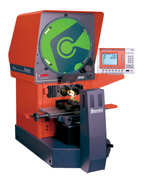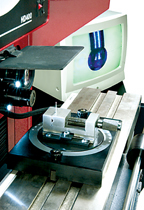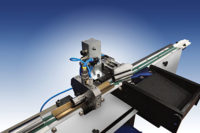

Although many may view optical comparators as basic measuring technology, projectors have evolved from simple comparative devices some 60 years ago to the more complex, precision optical measuring machines of today.
While some in the industry predicted that comparators would be replaced by newer
camera-based and video measuring systems, this is not the case. On the contrary, the versatile optical comparator continues to play a key role in measuring a range of parts that cannot effectively be gaged by conventional means. They are also a more practical alternative to video technology in many applications.
While large, basic floor-standing machines were the trend 20 years ago, advances in optics, readout devices, software and computation systems, and work-stage travel can now be found in compact equipment. Projectors are now available as benchtop machines or floor-standing models and have screen sizes that range from 12 inches all the way to 40 inches. Light path options are offered in horizontal or vertical orientations, based on the needs of the application.
Indeed, today's machines are markedly different from the first comparators, often called "shadowgraphs." As the name implies, measurement on a shadowgraph was accomplished via a shadow that was cast from a magnified image of a workpiece onto a screen with an overlay chart. Measurement by this means was somewhat subjective and part deviations were difficult to quantify, because the user could only compare the shadow to the actual part being measured. This process is basically limited to a simple go/no go pass or fail test with no additional measuring data gathered.

Evolution
While today's projectors can still be used for overlay or comparative purposes, most manufacturers are demanding more information about the parts they need to measure. As a result, the need for data has created more advanced optical systems, brought about primarily through the addition of software and readout systems. Readouts vary in sophistication from traditional micrometers and indicators to digital readouts, microprocessor displays with geometric measurement capabilities and PC-based systems.
In addition, edge-detection capability, which allows the system to automatically detect and measure transition points of a profile image, has become a common industry feature. The combined effect of these features has essentially transformed optical projectors from comparative tools to two-axis coordinate measuring machines.
Other automated features further enhance the capabilities of comparators. For example, a user may select a machine with manual, motorized or fully automatic operation. Fully automatic or computer numeric controlled (CNC) machines fitted with motors and edge-detection allow part inspection to be completed under CNC control. Users can run inspection programs to check parts automatically, without the need to manually navigate the machine each time a piece is inspected.

Expanding options
The advent of the geometric processor, or digital readout (DRO), which has evolved from a simple X/Y counter into an advanced computation system, is continually changing optical inspection ability.
For instance, software can interface to computer-aided design (CAD) to simplify part programming. This capability, combined with CNC control, allows features to be measured and constructed automatically with the results displayed on screen or documented through various reporting options.
Because of advanced readout systems and software, measuring routines have advanced so that comparators can calculate the diameter of a circle. While the earliest X/Y boxes would simply traverse the diameter from the extreme edge on each side of the feature to the other, as actual feature calculations were added, they often could only calculate the "best-fit" diameter of a circle. Today's systems can provide the maximum or minimum diameter, the average diameter based on all measurement points taken, or the mean diameter based on the high and low values. The form, or out-of-roundness, can also be indicated, shown simply on a graphical display.
Tolerances can also be applied to features, be they Cartesian, true position, maximum material condition (MMC) or least material condition (LMC). Readout systems are also flexible because they allow for software expansion, as programs continue to add enhancements.
A bridge to video
Moving a step ahead of the typical evolutionary comparator development pace are enhancements such as an
optical-to-video adapter. Developed recently, the adapter allows traditional optical comparators to be converted into manual video measuring systems by simply replacing the comparator lens with the new camera-based, video zoom package.
This optical-to-video adapter uses the same quick-change bayonet mount that an operator would use to change from a 10X lens to a 50X lens, with no tools required. In essence, it provides a cost-effective entrée to video measuring technology. This will allow users to obtain surface illumination at substantially higher magnifications than would normally be possible with comparators.
Some factors never change
Regardless of how advanced a readout system is or how powerful the software, optical equipment will not perform to desirable standards if a high quality, stable machine platform, superb lighting and high resolution optics do not exist. It pays to focus on these critical basics, being careful to evaluate each component of the system. Despite the fact that readout options and software can continue to be easily updated on a machine, if an optical system's foundation is inherently weak, overall performance and accuracy will be severely diminished.
Clearly, today's optical projectors continue to simultaneously demonstrate practical versatility while meeting new measuring challenges as they arise. They remain the proven workhorses of noncontact measurement.
Tech Tips
• Advanced optics, DROs, software and work-stage travel can now be found in compact equipment.
• Projectors are now available with screen sizes ranging from 12 inches to 40 inches and light-path options are offered in horizontal or vertical orientations.
• CNC machines fitted with motors and edge-detection allow part inspection to be completed under CNC control. Software can interface to CAD.
• Optical-to-video adapters allow traditional optical comparators to be converted into manual video measuring systems.
